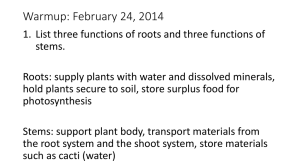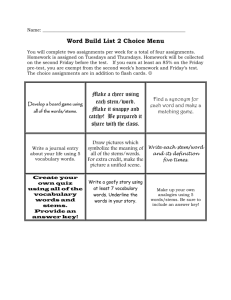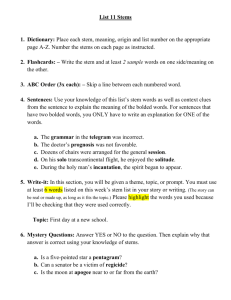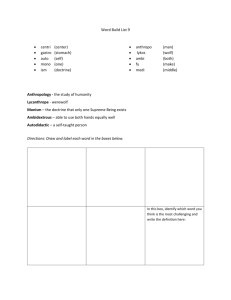Roots & Stems Plant Organs
advertisement
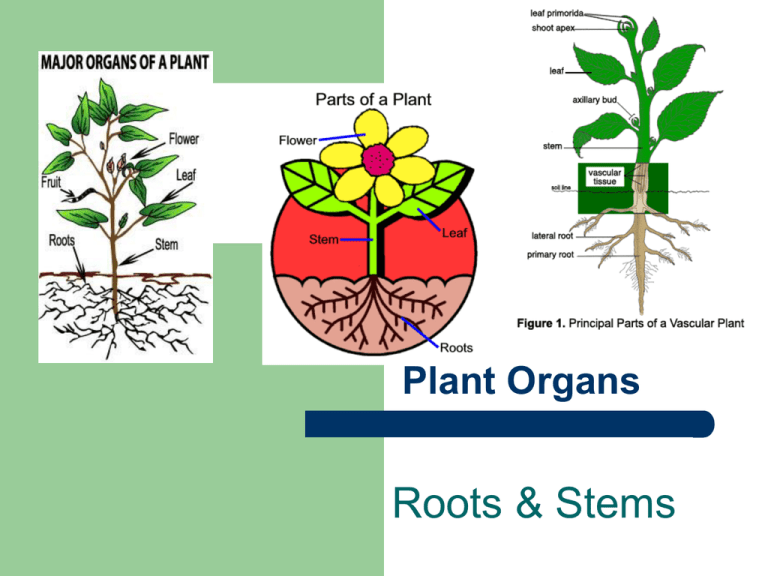
Plant Organs Roots & Stems I. Roots A. F(x)s = grow underground 1. Absorb water & nutrients from soil 2. Anchor plant in the soil 3. Make hormones important for growth & development I. Roots B. Structure 1. Root cap F(x) = protects apical meristem I. Roots B. Structure 2. Root hairs F(x) = increase surface area for absorption I. Roots B. Structure 3. Casparian Strip F(x) = *channel water & dissolved nutrients into vascular tissue *allow movement only into roots I. Roots C. Types of Roots 1. Taproots a. Large main root that can store food b. F(x) = absorption, anchoring E.g. beet carrot C. Types of Roots 2. Fibrous roots a. Numerous small roots b. Grow near surface c. F(x)= absorption, anchoring c. E.g. grass C. Types of Roots 3. Prop or Adventitious roots a. Grow down to soil from stem, above ground b. F(x)s = support, absorption c. E.g. corn, banyon tree C. Types of Roots 4. Aerial Roots a. Grow without soil, in air b. F(x) = absorb water from moist air c. E.g. orchids in tropical rainforest II. Stems A. F(x)s 1. Hold leaves up to sunlight 2. Transport water & nutrients from roots to leaves 3. Food storage in some plants II. Stems B. Stem Structures 1. Node – place where one or more leaves are attached Note: At the point of attachment of each leaf, there is a lateral bud with an apical meristem capable of developing into a new shoot II. Stems B. Stem Structures 2. Internode – part of stem between nodes II. Stems C. Specialized stems 1. Rhizome = horizontal underground stem 2. Tuber = Underground stem w/ buds Food storage E.g. potato, parsnip II. Stems C. Specialized stems 3. Bulb = large bud w/ layers Food storage Many edible E.g. onion, garlic II. Stems C. Specialized stems 4. Corm = Upright, thickened underground stem Food storage Not usually edible E.g. shamrock plant (Oxalis) II. Stems C. Specialized stems 5. Some plants almost all stem, no leaves E.g. cactus II. Stems D. Stem growth 1. Growth in Length – only at tips of stems where new primary growth occurs via apical meristems 2. Growth in Circumference – width via lateral meristems II. Stems E. Primary Growth in Stems 1. Vascular tissue arranged in vascular bundles 2. Dicots – bundles in a ring around outside edge 3. Monocots – bundles scattered throughout stem II. Stems Dicot stem CS Vascular bundles II. Stems E. Primary Growth in Stems 4. Pith – center of the stem 5. Cortex – ground tissue btwn. Vascular Bundles & epidermis Vascular bundle dicot monocot II. Stems F. Secondary Growth in Stems ¿Which get wider year after year, monocots or dicots? DICOTS! **Most monocots have no secondary growth. 1. ↑stem width in dicots due to cell ÷ in vascular cambium II. Stems 2. Vascular Cambium arises in vascular bundle btwn. xylem & phloem 3. Cylinder formed by cambium, then secondary xylem inside, then secondary phloem on outside of cylinder II. Stems G. Woody Stems 1. Heartwood 2. Sapwood 3. Bark DRAW THIS! II. Stems G. Woody Stems 1. Heartwood Dark color Center of tree trunk Dead xylem , no longer transports water F(x) = support II. Stems G. Woody Stems 2. Sapwood Lighter in color Nearer to outside of tree trunk F(x) = transport (live xylem) Note: In a large diameter tree, heartwood gets wider, sapwood stays relatively same width II. Stems G. Woody Stems 3. Bark F(x) = protection Made of cork, cork cambium & phloem II. Stems H. Stem F(x)s 1. Phloem moves sugars a. Translocation – sugars moved from source (photosynthesis in leaves) to sink (where they are stored) b. Products of Photosynthesis can move in ____?___ direction ANY II. Stems H. Stem F(x)s 1. Phloem moves sugars c. Pressure – Flow Hypothesis i. Sugars PUMPED into sieve tubes @ the source ii. Turgor = pressure increase due to water entering sieve tubes by osmosis II. Stems H. Stem F(x)s 2. Xylem moves water & nutrients a. Cohesion-Tension Theory combination of 3 processes: i. Transpiration ii. Cohesion iii. Adhesion Transpiration In leaves, release of excess water to atmosphere Creates negative pressure in xylem Replacement water pulled from xylem Water enters roots to replace lost water Cohesion Water molecules stick to each other & pull each other up narrow xylem tubes Water is a polar molecule, therefore Water molecules attract each other! Adhesion Water molecules strongly attracted to xylem wall II. Stems b. Final words on water movement in plants i. Varies with time of day ii. Midday – stomata open, rapid movement iii. Night – stomata closed movement stops Exception: cacti stomata open @ night ¿Why? to minimize water loss

